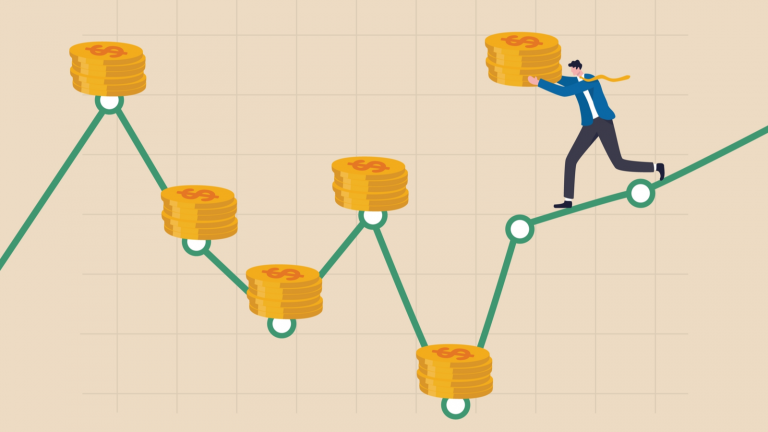Simply put, dollar cost averaging is the process of buying a stock, mutual fund or exchange traded fund (ETF) on a regular and consistent basis regardless of the price.
The purpose of this strategy is to lessen the impact of volatility and prevent investors from trying to time the market. With dollar cost averaging, which is also called a “constant dollar plan,” investors buy a stock sometimes when the price is up and sometimes when it is down. But, over time, they end up owning the stock at an average price that is somewhere in the middle.
Buy Low, Sell High
While many investors hold firm to the adage of “buy low and sell high” when it comes to stocks, the reality is that it can be very difficult to time the market. This is especially true for individual investors who are trying to save for retirement and don’t have access to the same technology as Wall Street professionals. Individual investors are also preoccupied with work and daily life and might not be able to monitor the ups and downs of the stock market on a daily basis. Even Warren Buffett himself has admitted that he has “not been good at timing” the market over more than 50 years of investing.
To get around this issue, many investors rely on dollar cost averaging, which is the process of investing equal amounts of money at regular intervals regardless of the price of a stock, mutual fund or ETF. For example, an investor might set aside $500 to invest at the end of every month and use it to build a position in consumer electronics giant Apple (NASDAQ:AAPL). Some months, They might buy shares of Apple as low as $100 each. Other months, the shares might cost $115, $127, $132, $145 and so on. Overtime, however, the average price at which they hold AAPL stock comes out to $123.80.
The main benefit of dollar cost averaging is that it helps investors avoid the mistake of making one lump-sum investment that is poorly timed. Using the Apple example, it helps the investor avoid buying their entire stake in AAPL stock at $145 per share only to see it fall. Dollar cost averaging is a strategy that investors can use to build and grow their savings over a long period of time. It helps to eliminate the impacts of short-term volatility in the stock market. Many investment advisors recommend using dollar cost averaging for people who want to save and invest money on a consistent basis and have long-term horizons.
401k Plans
The 401k retirement plans offered by many employers in the U.S. can help people invest money on a consistent basis using a dollar-cost averaging strategy. Money allocated to a 401k plan each time an employee gets paid is used to make regular purchases of a mutual fund, ETF or stock regardless of the price at a given time. Through a 401k plan, employees can choose a preset amount of their salary that they want to invest in a particular security. When paid, the amount the employee has chosen to contribute to the 401k is invested in their security of choice automatically at that time whether the investment is up or down. This leads to dollar cost averaging.
Of course, dollar-cost averaging can be used outside of 401k plans. It’s just that 401k plans automate the process and ensure it happens on a consistent basis. Also, dividend reinvestment plans allow investors to dollar-cost average by buying more shares of a company consistently over time regardless of the price at a particular moment in time. Many investment advisors recommend dollar cost averaging as a simple technique that helps to eliminate volatility and helps investors grow their savings over time. The technique can be used by experienced and novice investors.
Issues to Consider
If there is one flaw with dollar cost averaging, it is that it assumes that stocks, mutual funds and ETFs will always rise over time. For dollar-cost averaging to work, an investment must increase in price over the long-term. While the strategy can help to mitigate short-term market volatility, it cannot protect investments from sustained market declines or the collapse of an individual stock. Implicit in dollar cost averaging is the belief that prices will always rise given enough time. For this reason, dollar cost averaging is often most effective for investors with a time horizon of 10 years or longer.
Some critics of dollar cost averaging say the strategy is dangerous because it encourages investors to continue buying more shares in a stock at times when they might be best off to exit a holding completely. For this reason, some investment professionals recommend using dollar cost averaging to buy a mutual fund or ETF that tracks a diversified index, such as the S&P 500, or a basket of stocks, rather than employing the strategy to buy one particular stock.
Conclusion
Dollar cost averaging can help to lower the cost of an investment over time and help investors manage volatility and risk. The strategy can also help investors achieve greater gains on investments that rise in price. But dollar cost averaging does assume that prices will rise given enough time, so the strategy might best be used to invest in diversified mutual funds and ETFs rather than individual stocks.
On the date of publication, Joel Baglole held a long position in AAPL. The opinions expressed in this article are those of the writer, subject to the InvestorPlace.com Publishing Guidelines.

